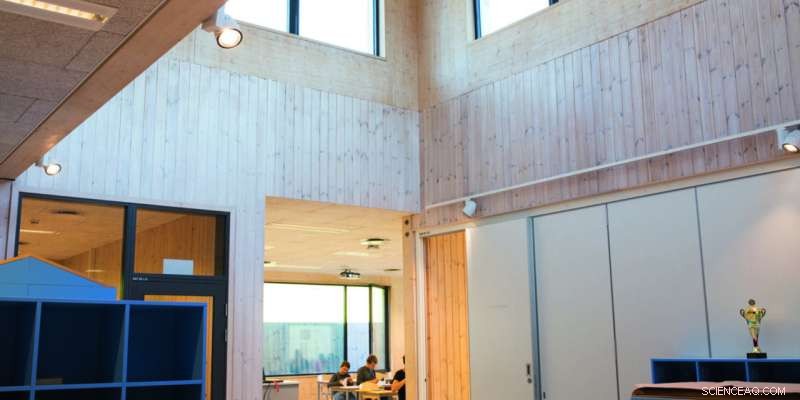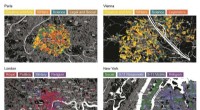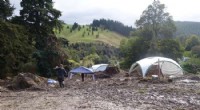
Wetenschap
Wat voor invloed heeft licht op kinderen op school?

Wetenschappers hebben onze huidige kennis verzameld over de invloed van licht op scholieren. Hun bevindingen kunnen leiden tot meer leren en minder verstoring. Op de foto zijn leerlingen van groep 7 te zien die het naar hun zin hebben op de Ulsmåg-school in Bergen. Credit:Architecten:Ola Roald Arkitektur. Foto:Eva Rosa Hollup
Wist je dat licht een factor is die zowel het leren als de psychologische ontwikkeling van schoolkinderen beïnvloedt? Het juiste soort licht kan de prestaties bij lezen, schrijven en rekenen verbeteren en rusteloosheid en agressie onderdrukken.
We hebben nu uitgebreid wetenschappelijk bewijs van de effecten die licht op mensen heeft. Licht is bijvoorbeeld direct gekoppeld aan ons dagelijkse ritme.
Dit ritme past ons lichaam aan aan een 24-uurs cyclus van licht en donker. Licht reguleert zaken als ons slaappatroon, lichaamstemperatuur en stresshormonen. Met andere woorden, daglicht is cruciaal om ervoor te zorgen dat ons dagritme werkt zoals het hoort.
SINTEF heeft onlangs een project afgerond om alle bestaande onderzoeksresultaten op dit gebied te bundelen. Het resultaat is een reeks gloednieuwe richtlijnen over hoe verlichting in schoolgebouwen moet worden ontworpen.
"Omdat licht invloed heeft op leerlingen in verschillende gebieden, is het belangrijk om meer onderzoek te doen naar hoe licht precies kan worden gebruikt in Noorse scholen", zegt SINTEF-onderzoeker Claudia Moscoso. "Goed verlichte leerruimten kunnen het onderwijs ondersteunen en een goede fysieke en psychologische ontwikkeling van scholieren bevorderen", zegt ze.
Lichtomstandigheden zijn erg belangrijk voor kinderen op school die veel tijd binnen doorbrengen. Het heeft invloed op hun alertheid, cognitieve vaardigheden en niveaus van het stresshormoon cortisol. Bovendien zijn de omstandigheden in Scandinavië zodanig dat hun blootstelling aan blauw licht in de ochtenden tijdens de lange wintermaanden wordt verminderd. Dit licht is essentieel voor het activeren van onze biologische klokken.
Grote vensters leiden tot betere examenresultaten
Uit een in 2015 uitgevoerd onderzoek in het VK (het HEAD-project), waarbij gegevens werden verzameld van 3.766 schoolkinderen in het VK, bleek bijvoorbeeld dat goed ontworpen basisscholen de academische prestaties van leerlingen op het gebied van lezen, schrijven en rekenen verbeterden. Een bevinding van bijzonder belang was dat 16 procent van de variatie in leerontwikkeling over een periode van een jaar kon worden verklaard door het fysieke ontwerp van het klaslokaal.
Deze resultaten lieten duidelijk zien dat licht de factor was met het grootste effect (21 procent), terwijl ook luchtkwaliteit (16 procent) en temperatuur (12 procent) een grote invloed hadden. Deze drie factoren waren dus verantwoordelijk voor bijna de helft van het effect op de leerontwikkeling.
Een ander wetenschappelijk onderzoek wees uit dat klaslokalen met grote ramen werden geassocieerd met tussen de 15 en 23 procent van de verbetering van de examenresultaten van leerlingen. It also showed that adequate and stable daylight conditions throughout the year boosted academic skills by between 20 and 26 percent, compared with classrooms with low levels of daylight.
Does adequate lighting promote less absenteeism?
A third study found that classrooms with adequate access to daylight and sunlight were associated with less pupil absenteeism and improved academic skills. On the other hand, classrooms with inadequate lighting design can restrict pupils' ability to learn. This is because low levels of lighting can impact on a child's visual system and thus restrict access to visual information and suppress learning ability.
In fact, the difference between classrooms with windows (providing adequate daylight conditions) and those without has been found to influence cortisol levels in children, which in turn are associated with pupils' psychological health and levels of concentration in the classroom. Another major research project , which used data taken from 2,837 schoolchildren aged from eight to 12, found that pupils working in classrooms with large windows exhibited better academic skills compared with those in classrooms with less window area.
In the case of artificial light, research studies have found that variable levels of lighting (i.e. Illumination that varies both in strength and color temperature) serve to boost academic skills in reading speed and comprehension. For example, skills in reading aloud were increased for 38 percent of pupils working under variable lighting conditions, compared with only 18 percent for those under normal white light.
It has also been found that blue-enriched white light reduces restlessness and aggressive behavior among schoolchildren compared with standard white light.

The entrance area of Fagereng school in Tromsø photographed in daylight during the summer (left) and under artificial lighting in winter (right). Architects:Fråne Hederus Malmström arkitekter and Arkitektlaget. Credit:HMXW arkitekter and Solvår Wågø/SINTEF
Many variables
Even though minimum lighting requirements have been stipulated for Norwegian schools, these do not in fact guarantee adequate lighting quality in any given school space. For example, the requirements linked to daylight, such as daylight factor (DF), describe an average value for overcast weather.
"If a classroom only succeeds in achieving the minimum requirement of 2 percent DF as set out in the Norwegian statutory building regulations (TEK17), or the Lyskultur recommendation of 5 percent DF, the same classroom may still encounter issues with glare or overheating under clear skies," explains Moscoso.
Moreover, the requirements for artificial light offer inadequate information about the color temperature of the light source. In fact, research has shown that the color temperature of a light source impacts on both the behavior and psychological and mental states of pupils.
So, in order to carry out a comprehensive assessment of lighting conditions in schools, we have to analyze other parameters. For example, classrooms should be monitored to identify issues linked to glare. We should be noting the colors of surfaces and assessing whether the pupils' visual environment is good enough to provide them with mental and visual "relief."
Linked to architecture
Classrooms and group rooms are among the most important learning spaces in any school.
"This makes it very important to evaluate the floor plans and physical design of such spaces," explains Moscoso. "For example, we must look at daylight openings (windows and skylights, if any) and their design, the types of glass, installation angles, as well as the accessibility of sun-screening or daylighting systems," she says.
The aim of daylighting systems is to make better use of daylight, for example by allowing it to penetrate deeper into a space, or by distributing the light more evenly. Even if these factors have already been considered during the design phase, it is also common to retrofit them in existing buildings.
"It's also beneficial to focus on the arrangement of furniture in a space, the color and reflectivity of surfaces, and the location of whiteboards and suchlike. This can provide us with important input during our analyses of light distribution, contrasts and factors that can cause glare," says Moscoso.
Improving light conditions
The researchers have now attempted to identify a suitable method that incorporates the most important factors that should be assessed in the search for a well-lit classroom. Their literature review offers an evaluation of the most important aspects of lighting in school spaces and the methods that can be used to record light conditions in our schools.
"This information can be used in the future either to evaluate and improve existing light conditions in schools, or serve as a set of recommendations during the planning of new schools designed to support learning and well-being," says Moscoso. + Verder verkennen
Smart lighting system based on quantum dots more accurately reproduces daylight
 Rundvleespeptiden blokkeren bittere smaken
Rundvleespeptiden blokkeren bittere smaken De sleutel tot verbeterde efficiëntie van groene technologie gevonden in eenvoudige zuurbehandeling
De sleutel tot verbeterde efficiëntie van groene technologie gevonden in eenvoudige zuurbehandeling Antivriesvissen inspireren nieuwe cryoprotectanten voor menselijke cellen en weefsels
Antivriesvissen inspireren nieuwe cryoprotectanten voor menselijke cellen en weefsels Onderzoek naar stikstoffixatie kan licht werpen op biologisch mysterie
Onderzoek naar stikstoffixatie kan licht werpen op biologisch mysterie Simulaties verklaren detonatie-eigenschappen in TATB
Simulaties verklaren detonatie-eigenschappen in TATB
 Veranderingen op korte termijn in de ijsplaten van Antarctica zijn de sleutel tot het voorspellen van hun lot op de lange termijn
Veranderingen op korte termijn in de ijsplaten van Antarctica zijn de sleutel tot het voorspellen van hun lot op de lange termijn Dag Alfa, Eta:Grieks alfabet gedumpt voor orkaannamen
Dag Alfa, Eta:Grieks alfabet gedumpt voor orkaannamen De bodem is onze beste bondgenoot in de strijd tegen klimaatverandering, maar raakte snel uitgeput
De bodem is onze beste bondgenoot in de strijd tegen klimaatverandering, maar raakte snel uitgeput Marshall eilanden, laaggelegen bondgenoot van de VS en nucleaire testlocatie, verklaart een klimaatcrisis
Marshall eilanden, laaggelegen bondgenoot van de VS en nucleaire testlocatie, verklaart een klimaatcrisis De soorten tropische hagedissen
De soorten tropische hagedissen
Hoofdlijnen
- Hoe werkt het skeletsysteem met het ademhalingsstelsel?
- Evenwichtige bemesting:een steunpunt voor duurzame productie van maïs en rijst in Afrika
- Wat is een adaptief voordeel voor het beperken van DNA in een kern?
- Wat is het belang van nucleïnezuren?
- Wat is een gespecialiseerd gebied van het endoplasmatisch reticulum?
- Meeluisteren:akoestische bewakingsapparatuur detecteert illegale jacht en houtkap
- Een bitter mysterie:wetenschappers sequencen 's werelds oudste plantengenoom van 6000 jaar oude watermeloenzaden
- Ecologische successie: definitie, types, stadia en voorbeelden
- Geen bewijs dat het onthoornen van zwarte neushoorns een negatieve invloed heeft op de voortplanting of overleving van de soort, studievondsten
- Streetonomics:straatnamen gebruiken om de culturele waarden van een stad te kwantificeren

- Het lerarenverloop is een probleem - hier is hoe het op te lossen

- Meer dan acht op de tien mannen in de gevangenis leden aan tegenspoed in hun jeugd - nieuw rapport

- Levendig gladiatorenfresco ontdekt in Pompeii

- Onderzoekers onthullen geschiedenis door opgraving van Otago-graven

 Demonstranten protesteren tegen hervorming EU-auteursrecht op internet
Demonstranten protesteren tegen hervorming EU-auteursrecht op internet Onderzoekers ontwikkelen een neutronendetectorarray met lage achtergrond
Onderzoekers ontwikkelen een neutronendetectorarray met lage achtergrond Wiskundig model voorspelt de beweging van microplastics in de oceaan
Wiskundig model voorspelt de beweging van microplastics in de oceaan Belasting weg, subsidies in:Australië en de VS betalen hoge klimaatrekeningen, zonder CO2-belasting te belasten
Belasting weg, subsidies in:Australië en de VS betalen hoge klimaatrekeningen, zonder CO2-belasting te belasten Wat zijn de wintermoessons?
Wat zijn de wintermoessons?  Bijna de helft van de werelderfgoedlocaties zou tegen 2100 . hun gletsjers kunnen verliezen
Bijna de helft van de werelderfgoedlocaties zou tegen 2100 . hun gletsjers kunnen verliezen Millihertz quasi-periodieke oscillaties gedetecteerd in een röntgendubbelster
Millihertz quasi-periodieke oscillaties gedetecteerd in een röntgendubbelster Toevallige vondst heeft grote gevolgen voor de kosten van waterbehandelingen en de ecologische voetafdruk
Toevallige vondst heeft grote gevolgen voor de kosten van waterbehandelingen en de ecologische voetafdruk
- Elektronica
- Biologie
- Zonsverduistering
- Wiskunde
- French | Italian | Spanish | Portuguese | Swedish | German | Dutch | Danish | Norway |

-
Wetenschap © https://nl.scienceaq.com

